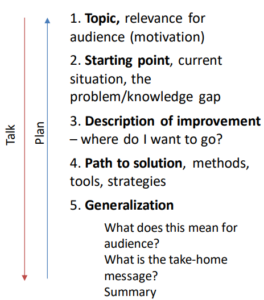Timeline
Think about ideas: May 16th
Submit abstract/outline (150 words): May 27th
First feedback on idea: May 30th
Input on Poster Design: June 6th
Organizing poster session: June 13th
Q&A on posters: June 20th
Poster draft feedback – speed dating: June 27th
Poster session: July 4th
Poster topic
What are – or could be – our key contributions to researching and shaping climate futures?
Your poster: select one specific strategy of adapting to or mitigating global change (e.g. a regulatory intervention, specific consumer behavior, a nature-based solution). The poster should deal with the 1) knowledge/research which is necessary to support this strategy and 2) an effective way to communicate/implement this strategy.
What to think about when designing a poster
Audience
- What is the target group? (in our case: the extended CLICCS/SICSS community)
- Which knowledge can be assumed?
- Which language will be used?
Core message
- Which message do I want to convey?
- What should be the main takeaway?
Balancing act
- Poster must stand on its own (but will also be presented)
- Textual information : visual information
Preparation
- What do I want to say (1 sentence)
- Thinking, material collection
- Sorting (5-step procedure):
What a good poster involves
- Tells a story (textually/visually)
- Extracts key information
- Is well-designed (separate input on June 6th)
- incl. legible, efficient use of space, not too much text, good combination of visual/textual information, clear structure and sequence
- Can be read from top left to lower right. Stress positions: top left and lower right, here you find the core information
- Balance visuals and text – 50:50, but better 60:40 (start with key visuals; do they cover the main point?)
- Can be understood from far/ on an A4 print-out
- Use headers to structure your poster
- Start with figures and adapt text accordingly (NOT the other way around!)
- For examples, see lecture 5 slides
Introduction
- Motivation, overview
- Mental road map
- Raise interest
Sections
- Structure
- Create re-entry points
Closing
- Repeat core message
- Find good closing sentence
References
- Include abbreviated references with names, not just DOI
- Also include QR code with full list

